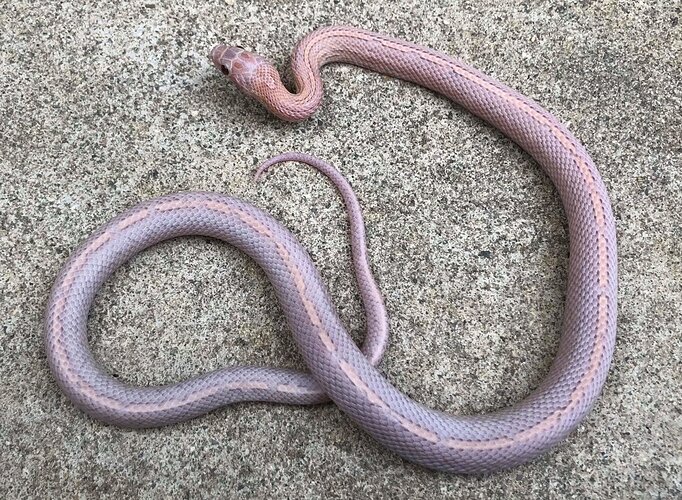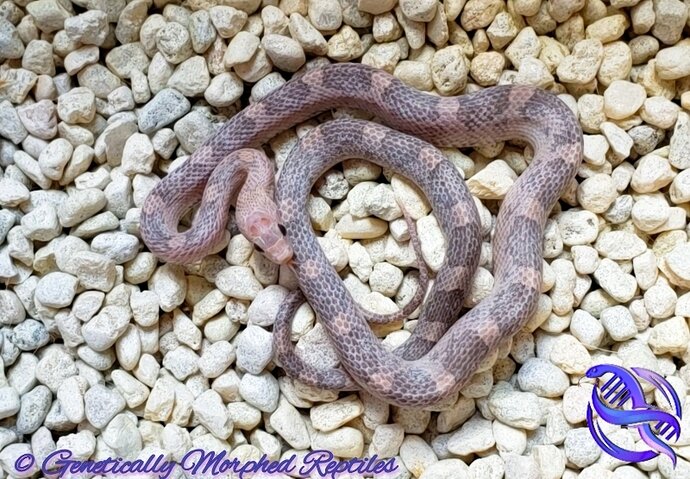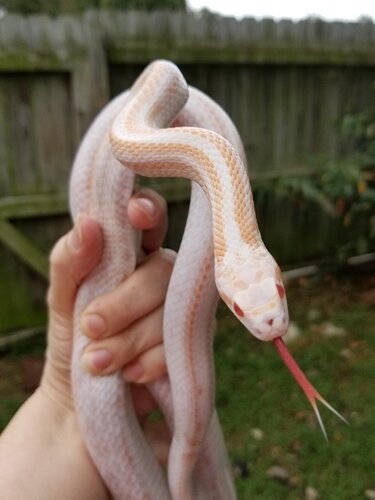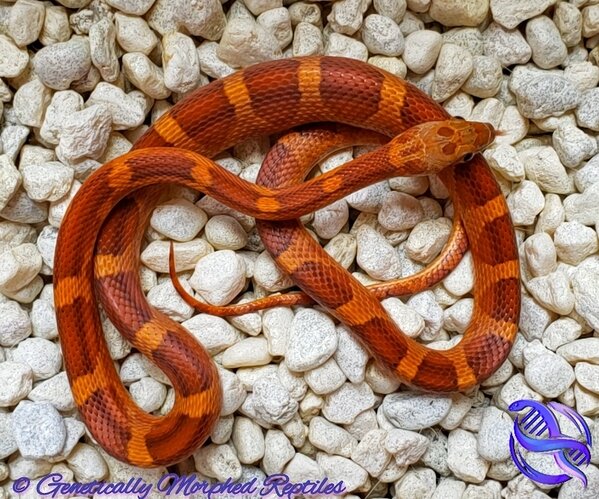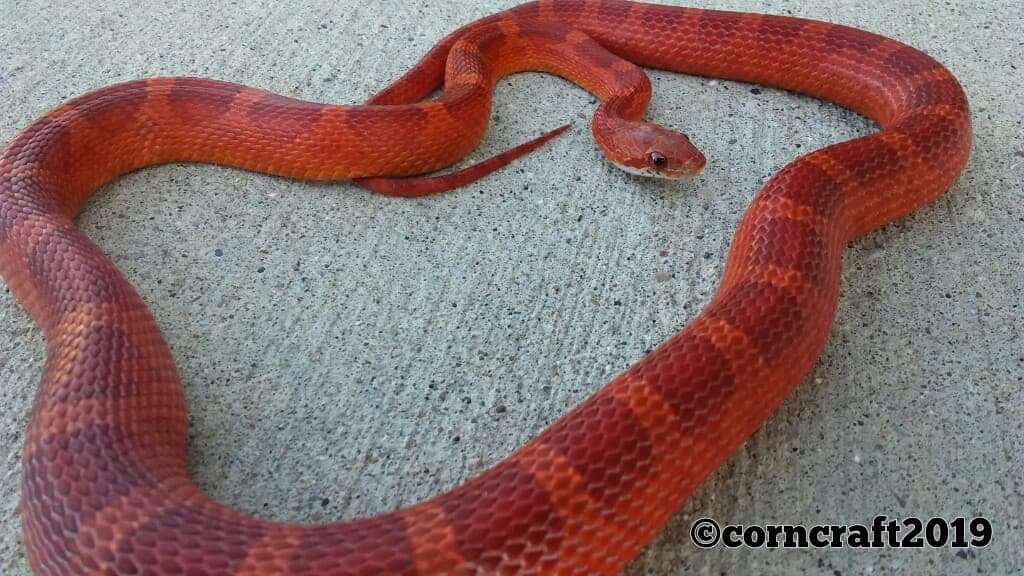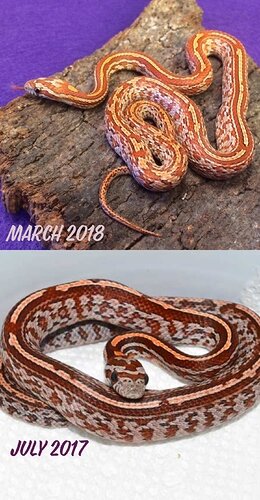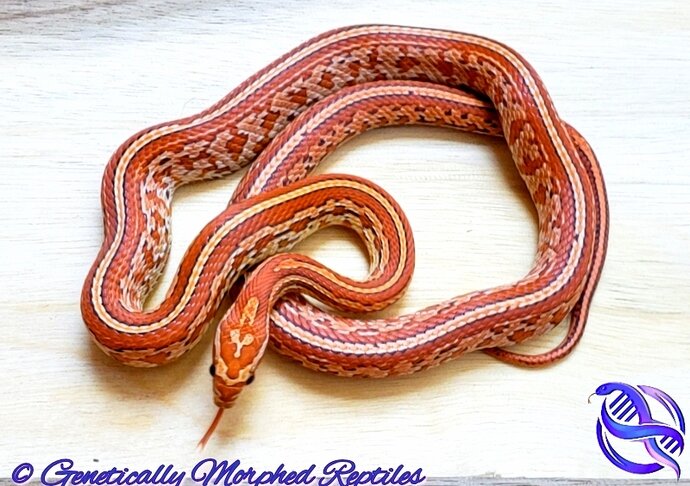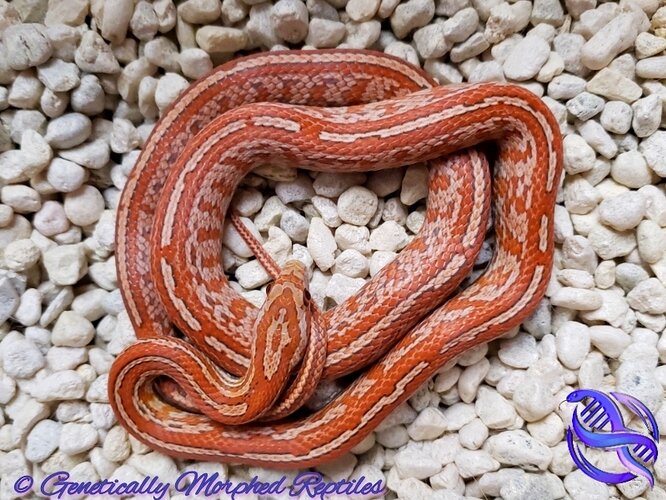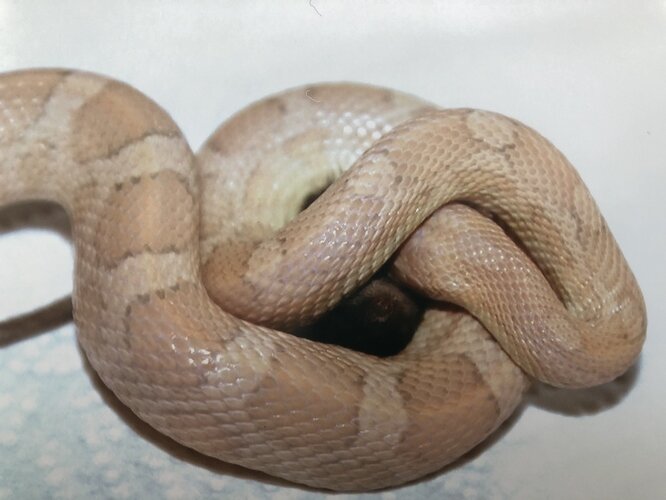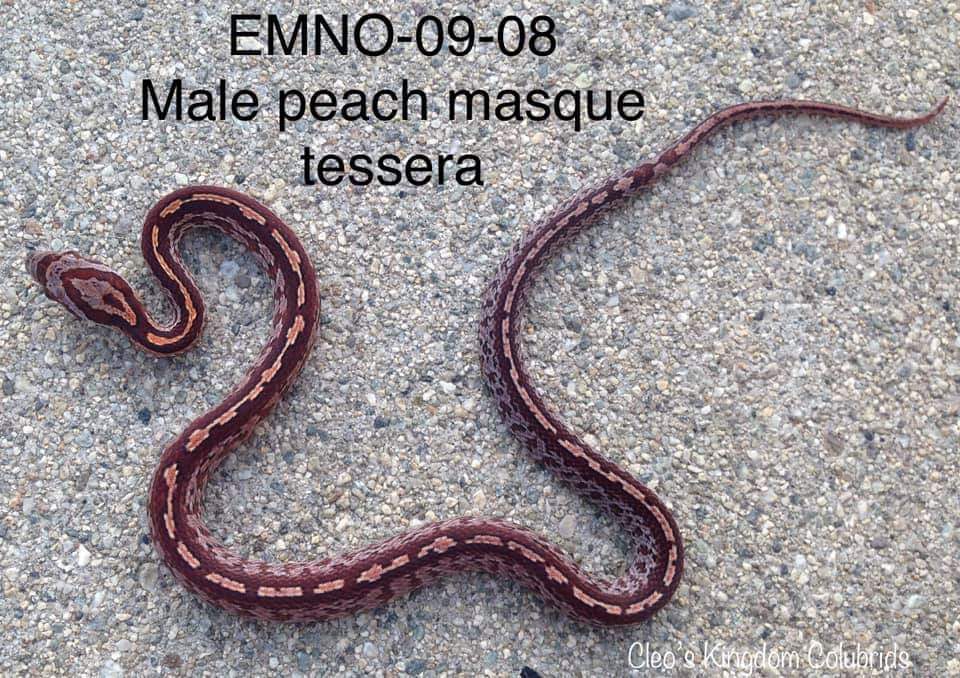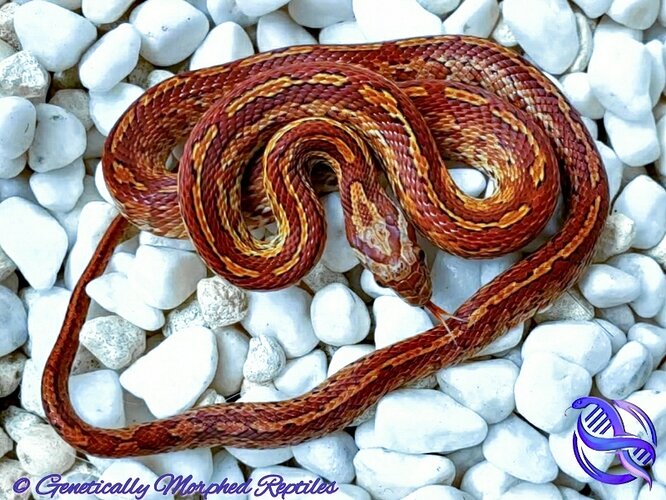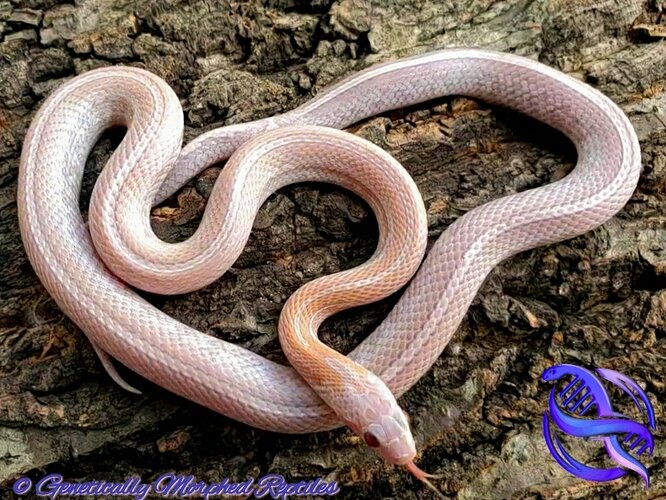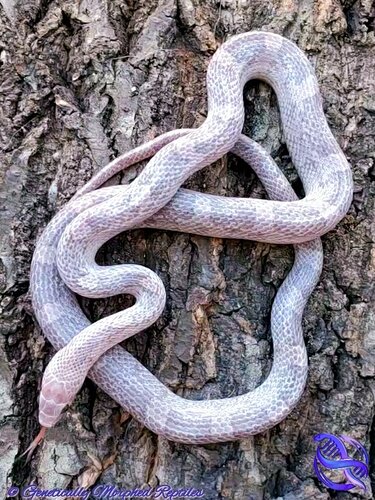Is there anyone here who breeds corn snakes and is familiar with the Rich Hume Peach Line? Specifically his Peach Lavender/Plasma line? I’ve inherited the job of figuring out what peach actually is since Rich retired from being corn snakes at least. I’ve been working with the line now for 3 years and I’ve come up with some interesting results. I would love to discuss genetics with sometimes in regards to these if anyone is familiar and wanting to chat about it. Drop me a line here if you are familiar and would like to talk genetics.
I would love to hear more about it. The little I know about it is from the single page about it in Sarah Mohr’s recent book.
From what I remember back in my day of breeding corns. Peach is a specifically nice Caramel Hypo Lavender. Others have produced them but not as nice as the original one. I was once working with really nice ambers and Hypo lavenders in hopes to produce a gorgeous peach corn. Unfortunately I got out of corns back in 2008. I did have several Hypo holdbacks hey for caramel lavender.
I also produced really nice Hypo butters back in 2007.
@sickpyth7 I thought Caramel Hypo Lavenders were called Amarettos. Either way I believe the Rich Hume Peach line @gmr2014 is speaking about is not the same thing.
Yes I think your right, back in the early days Amaretto didn’t exist. But Rich Hume’s Special snake did. This was so many years ago so I could be wrong. I still have the photo of the peach corn in my picture album. I printed it back then.
Still hoping to hear about your interesting results @gmr2014
Okay sorry I didn’t continue with the conversation sooner but I got tied up with some projects here at home. Here’s what I know and can say for sure. I know that there are a couple of things that people believe Peach is. I believe originally, some of the original ones they said were Peach did carry caramel and possibly the true Peach at the same time but the line I started with from Rich back several years ago and the line he continued to work with through the years did not have Caramel in it at all. Her did try to figure out at certain times what Peach is but never did figure it out. I know none of mine carry Caramel in homozygous form though I think one pair I bred last year did have Caramel as a het but that doesn’t surprise me since the line started with a project that Vinny Ritchie started by pairing a Hypo Plasma x Amber. What happened was that instead of producing the expected full clutch of Hypos het for Caramel Lavender and Diffused, he got only about half the clutch of Hypo and the other half were classics. Here’s the thing. Rich bought, I believe 1.2 of the classics and that’s when he started producing the Peach line. My theory on why he got only half Hypo and the other half classics is as follows. I know he proved that his Amber was an Amber for sure so that leaves the Hypo Plasma as being the culprit that carried the Peach mutation. When I say mutation, I say that knowing that Rich did prove that whatever Peach was that it was a genetic mutation but never got beyond that. Why, I’m not sure. What I’ve discovered over the years that I’ve been breeding them, is that whatever Peach is, it’s a hypo type mutation but it’s definitely not a known hypo mutation or allelic to the any of the hypo types we currently know and it seems to be acting as an incomplete dominant mutation. My very first clutch (Peach Plasma Tessera het Amel x Opal Blood), I noticed an odd peachy coloring on the hatchlings center dorsal stripe but didn’t realize then that it was due to the Peach. See the male Opal Blood I used to breed my Peach Plasma Tessera with was just a normal looking Opal Blood. There was nothing special looking about him but I didn’t know at the time I bred him to my female he was from Rich Hume’s Peach Line. The person I got him from never divulged that information until after I started seeing and talking about the odd color on my hatchlings develop even more as they shed each time and especially with one particular one that drastically started changing color. I asked her where she got the him from and she told me he was from Rich. I contacted Rich about it wondering if it was from his Peach and he told me that any lavender based corn snake from him is from his Peach Line. Now my thought at the time was that obviously the make I used turned out to be het and that’s how I wound up producing my first homozygous Peach Plasma Tessera. What I couldn’t understand at the time was if he was a visual Peach then what was going on with my others? There was obviously something going on, but what? The only thing that I didn’t notice was any color differences in the Opal Blood and the Opal Blood Tesseras. The next couple of years, I had phone conversations with Rich in regards to what he saw with his hatchlings and what I noticed with mine. Many of the things I noticed he confirmed that he saw too but never thought anything about it in regards to the ones that should’ve been just het, if he saw any indication of visual Peach they were just Peach. He never took into consideration that the mutation was an incomplete dominant mutation. I think (and this is just my opinion as to what I took from our conversations) that he never really delved too much into the why’s, what’s, where’s and when’s, just as long as they were. What I’ve come to realize is that in the homozygous Peach mutants, it almost always involves the entire color even though there is a color difference between the front and the back of the snakes body but when it comes to heterozygous mutants it typically only involves the front half of the snakes body at first but as it grew it would become more involved but was actin much more muted than the homozygous version! I’ll provide photo evidence of what I am talking about. I also noticed that whenever an Opal mutant was declared a Peach it was a patterned type, meaning that any Opal Tessera, stripe, motley or whatever that showed color as an adult was considered a Peach yet the ones that weren’t Peach were the non patterned mutants. Regular Opal Bloods like my original Opal Blood that was obviously not a visual Peach mutant was sold as just an Opal Blood or whatever. Over time I came to realize it was because like other hypo type mutations it doesn’t affect the color of the Amel based mutants. What I came to understand was that the ones that were sold as Peach Opal Blood Tesseras, Stripes or Motleys, etc, were colored only because of their natural colors were lined up along each side of the dorsal stripes or patterns. I have some photos I’ll add to the conversation of my personal collection or lines live produced but since have sold.
The first one here is a female Peach Plasma and I believe she’s a homozygous Peach Plasma. She was purchased from Rich Hume. She should be breeding next year.
This next pic is the male I produced the very first year I breed my Peach Plasma Tessera x what I thought was a regular Opal Blood but turned out to be from Rich’s Peach Line. This is the latest pic I had of him which was just a month or two ago.
The next pic is of a hatchling from last year I produced what what I thought was a pairing of a Peach Plasma Tessera x Peach Opal Blood Tessera. I also paired the same male to a WC female to do some trials on to figure out if it was in fact an incomplete dominant mutation. Forever, with my Peach to peach pairing hatched, I quickly realized there didn’t seem to be any homozygous peach hatching in the clutch and there were even some that didn’t seem to have any. This revealed to me two things. A. My female Peach Plasma tests is likely het Peach and not homozygous Peach and B. That the male I used had no Peach at all. I’m also going to post a pic of the sire to show you why he thought it was a Peach, but understand, I believe its coloring comes from the typical peachy Pink coloring you usually see as a hatchling but as it ages it fades away and/or if it’s a patterned mutant it displays it surrounding the edging of the pattern like the saddle spots of the Motley pattern, the Stripe or Tessera Stripe pattern. This one here is the one I produced last year and is believed to be a visual het Peach Plasma.
The next one is the male used to produce her and then the female Peach Plasma Tessera used to produce her and I’m fairly sure she’s also only a visual het Peach.
Sire
Dam
Sorry for no full body shot but because of her diffusion this shot shows the peach the best.
Here’s a pic of a Bloodred from last year that is also what I believe to be a visual het but it’s also possible it’s a homozygous Peach. He had siblings that were obviously Peach but he was the one that showed it the best. That may be due to him being homozygous but I won’t know until I can breed him.
Here also a sibling that was sold to someone else and has kinda been pushed to grow a bit faster tho I must admit the pic of mine is a bit older and not his true current size but shows his colors best.
This next pic is actually a collage of a Tessera that is visually het for peach. There are no other visual mutations involved. All of its other genetics are in het form and are recessive other than the Tessera. This collage shows it as a hatchling and then almost a year later about 10 months of age. It shows how it seems to act as a hypo type mutation but certainly very different from the others.
Last but not least is a pic of what is believed to be a homozygous Peach Tests that I currently own. She’s definitely different than any other hypo types I’ve owned and I’ve studied het next to other hypo types her age and just can’t find any similarities that says she’s anything but Peach.
Just to give you some perspective here’s a pic of my Lava het Cinder which seems on the surface similar but close inspection shows colors are very different.
So there you have a bit of the back story, a bit of the current story. What the future holds? Who knows? I’m continuing to do trials to prove its not related to any of the other hypo types tho there are some out there that are a combination of hypo and peach which again is a very different look unto itself but due diligence would require me to do the tests to prove it out in documentation. It’s going to be a few more years before I can declare without prejudice that it is an incomplete mutation that isn’t related to any other hypo type but it’ll be well worth it when I can finally make that call to Rich and give him the results he’s been wanting as well as others for so long.
Any questions please don’t hesitate to ask. I can also be reached on Facebook under Genetically Morphed Reptiles or Terri Faye House and please don’t hesitate to message me to chat more about it as well. I have plenty more photos that I can show but just couldn’t add to this without spending a year adding them all. Envoy!
This is the first photo I’ve ever seen when peach was mentioned online 15+ years ago. I saved it and have it in my corn snake album.
Awesome info @gmr2014 thank you for sharing. Do you know if any trials have been done with Peach to Kastanie?
Okay, I have not read all of this but
These two statements are mutually exclusive. If Vinny’s classic animals that Rich acquired are the source for this gene in Rich’s collection then it cannot be inc-dom because if it was then the animals Rich picked up would have been displaying the trait and therefore not classics.
Actually after talking to Rich about it he said he noticed that they did look like very nice looking classics which is what they look like as hatchlings they look like very colorful classics with some peachy coloring on the dorsal ridge in the ground zone.  as you can see in these pics of you weren’t looking for a new completely looking mutation these look like just really colorful Classics. When Sean Niland hatched these out he too thought they were and labeled them as Classics het Peach Plasma Ph Amel. It wasn’t until after we had a discussion and I showed him pics of the same snake a year later and the fact that he had a Tessera het Peach Plasma left over the following year prior to breeding season that he realized that there was definitely something going on beyond a recessive mutation. We have done a trial this past year and so far the hatchlings looked as expected and are changing as expected.
as you can see in these pics of you weren’t looking for a new completely looking mutation these look like just really colorful Classics. When Sean Niland hatched these out he too thought they were and labeled them as Classics het Peach Plasma Ph Amel. It wasn’t until after we had a discussion and I showed him pics of the same snake a year later and the fact that he had a Tessera het Peach Plasma left over the following year prior to breeding season that he realized that there was definitely something going on beyond a recessive mutation. We have done a trial this past year and so far the hatchlings looked as expected and are changing as expected.
Here are some early pics of the hatchlings from the trial we did this past year.
That was his after first shed pics. Now keep in mind these hatchlings look a bit more red and almost a pinkish peach but this is because the original WC pair that produced the F1 female she paired her homozygous Peach Plasma Tessera het Amel with were very red WC, I believe they were caught in the Devils garden in Florida but anyway she was extremely red so the hatchlings are very red looking however they still have the Peach coloring and are in the process of changing their colors as we speak. Here’s.a more recent pic of the same snake and you can see how much he’s changed just in the time between pics
There will be a lot more changes going on as he grows.
Here’s a pic of what I am pretty sure is a het Peach Ghost Plasma Tessera. I’ve talked to Sean and he seems to think the same. and here’s a pic of his sister the only other one in that clutch that turned out het Peach.
If anyone has any further questions don’t hesitate to ask.
I know there are folks out there working with Peach, and there is some good info in the post above, also here: Search results for 'peach corn' - MorphMarket Reptile Community; and in S. Mohr’s book. Would it be possible to get Peach added to the available mutations/tags here on MM? I’m happy to begin a write-up for it but I’m 100% sure there are folks out there who are more familiar with this mutation and its history than I am ![]() . Same thing goes for Specter. I’ve seen Heliconias for sale on MM, but there is currently no way that I am aware of to tag them so that potential buyers can easily search for them.
. Same thing goes for Specter. I’ve seen Heliconias for sale on MM, but there is currently no way that I am aware of to tag them so that potential buyers can easily search for them.
I would truly love to see Peach added. I’ve done a lot of reading and research, and I’ve got several Peach corns. I haven’t actually produced any Peaches yet: mine are 2021s and 2022s. I have been attempting to pair a 2021 Peach Fire het Caramel Lavender male with a UK Caramel Diffuse ph Amel female, so I am hoping to make some Diffused Caramel Peach babies this season, maybe even Diffused Peach Butters. I would be happy to help with a write up, if that’s wanted. It would be fantastic if someone who’s been producing them wants to do the feature request. And yes, Specter and Heliconia could do with an official tag, too.

